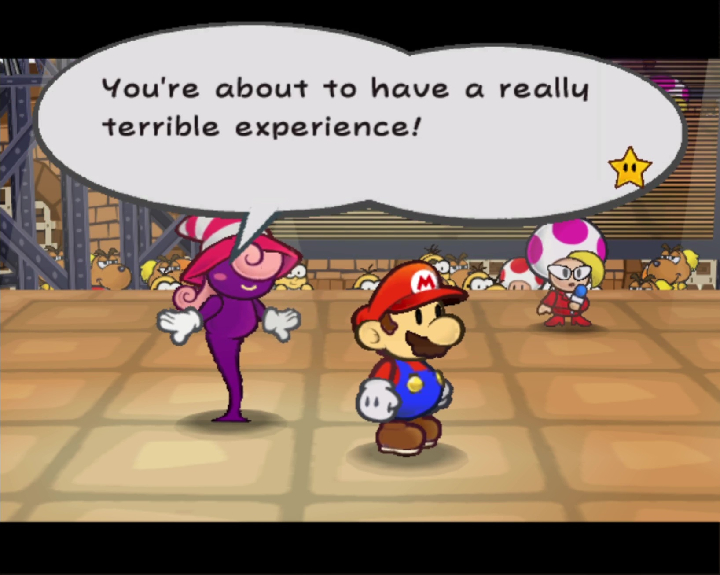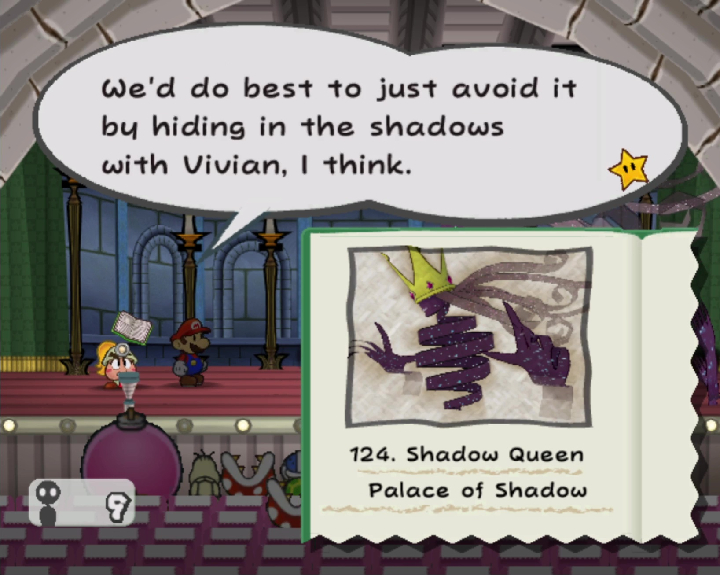
The variants of The Thousand-Year Door have more in common than they have differences. The text I’ve considered is a minuscule fragment of a sprawling script. How little about Vivian was changed from the original to the remake may indicate how uplifting a trans character the 2004 release depicted, despite its ignorance. Her transgender status is not used as a joke. The writing treats her no differently than the various other cute girls who kiss and flirt with Mario. (Every single woman in his party kisses him.) Though she displays gender variance, this is not her only defining trait. She is happy with herself and remains feminine to the end (compare that to, for instance, the quashing and rejection of queer identities in Summon Night: Swordcraft Story). Vivian is heroic, polite to a fault, given a cute design, considered extremely attractive by other characters, and no less intelligent than the rest of Mario’s crew.
A limitation of the writing is that any one party member can be active in any given scene. As a result, despite their different personalities and motives, their dialogue and actions are largely variations of the same observations and thoughts (though this would not be obvious except upon more than one playthrough). Ironically, the longer a character goes before joining Mario’s party, the more he or she can be developed. Vivian receives more opportunities for characterization than any party member besides Goombella and Ms. Mowz. She also enjoys a fuller arc (arguably) than the other party members, switching from villain to hero, courageously escaping an abusive situation, becoming stronger than her sisters, and thwarting their plan to conquer the world. Her major role in Chapter 4, more prominent than any other party member’s in the whole adventure aside from Goombella’s, may also be thematically relevant to her being a trans woman: she chooses to help Mario specifically when he is without his rightful body and nobody respects his identity (another point favoring a trans interpretation even in the original).

Like the abilities of Mario’s other party members, Veil remains indispensable to avoid obstacles throughout the subsequent chapters, ensuring Vivian remains consistently in use in the gameplay. In the finale, Vivian also has the honor of being essential in a way no other party member is: With Veil, she is the only one who enables Mario to avoid the Shadow Queen’s deadly charged attack. This is particularly notable because the twist ending reveals Beldam is effectively the Shadow Queen’s understudy. Though in the last Three Shadows boss fight Vivian can boldly declare she will punish Beldam this time, completing her arc, the player is not required to use her there. But because Veil is (at least almost) essential for the Shadow Queen battle, Vivian also, in this way, must be used against Beldam’s plot no matter what other party members the player chooses to utilize in the final boss fight. This ensures she will complete her arc and thwart Beldam at the climax.
However, Vivian’s story has a somewhat strange ending. The epilogue takes the form of a letter Goombella writes to Mario some time after the finale. Beldam has been portrayed as a relentless and cowardly abuser and deceiver motivated by devotion to an evil demonic conqueror who feeds people to dragons. In her last several appearances, Beldam has unfailingly tried to kill Vivian. But Goombella indicates Vivian has returned to live with Beldam and Marilyn. She also writes that, with the loss of the Shadow Queen, Beldam has given up on evil and promised to never be mean to Vivian again. The accompanying visual shows Goombella chatting with a happy Vivian in Twilight Town. This abrupt resolution is unearned. Beldam shows no redeeming qualities before this point, and the notion that such a deceptive, selfish character could be taken at her word strains credulity.